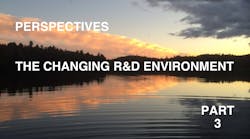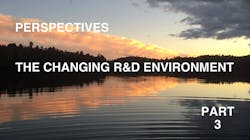Top 12 Trends In The Science of Managing R&D and Product Development: Perspectives
This file type includes high resolution graphics and schematics when applicable.
Twelve trends affecting the science of managing R&D and product development are described in my January and February articles. In this “bonus” installment, we look at what these trends mean to the evolution of product creation and commercialization.
"Big data" is a macro trend influencing each trend. First coined around 1970, "Moore's Law" describes the doubling of computing capability every two years. Forty-five years later, that doubling is reaching epic proportions. While the cost of data storage was once immense, today it’s among the smallest of considerations. The challenge now lies in culling-out real information from the myriads of data.
We now have amazing computational and communication tools we wear or carry around. Since 1980, the number of bits per second sent through optical fibers has increased 10 millionfold. We no longer have to be in the same house or office to provide or access needed information. From this perspective, companies do not differ much from individuals or families. They are just entities with larger domains, albeit the same basic needs and wants.
So how do we cull-out the needed information from amongst all the data? The solution to that question can be found in the “Internet of Things" (IoT), where seemingly everything is headed. Just about every past and future product will be designed or redesigned to facilitate the IoT endgame. In the future, products will be second-class unless they propagate information into and pull information out of a networked information repository few currently comprehend—a giant and universally accessible data bank.
Quick access to information lets people manage strategy in VUCA times (Trend 2). It is the reason for Web 3.0 (Trend 5). Once in place, it will facilitate improved Organic Innovation (Trend 4) and Open Innovation (Trend 11). In the case of Organic, companies that master it will out-invent their competitors. Companies that don't will Openly Innovate from those that do. Measurement and Correlation (Trend 10) will be achieved because of the "infinite size" of the data set. These factors, in turn, will continue to drive the refinement and understanding of the ownership of Intellectual Property (Trend 12). And issues regarding the efficiencies of Physical Versus Virtual Work (Trend 9), will disappear as geographic location becomes increasingly less important.
Moore's Law also describes a geometric shrinking of size. Computing industry knowledge continues to spill into every other industry from motors to health care. Everyone wants more capabilities occupying less space, Micro-Nano Effects (Trend 8). This trend, coupled with the long-held manufacturing goal of producing low-cost lot sizes of one unit at a time, will keep Engineering and Development Automation (Trend 7) on a tear for years to come. Low-cost lot sizes of one are not possible if humans touch the product. Rapid Prototyping (Trend 1) is one solution. Eventually, it will evolve to deposit atoms versus molecules and the Micro-Nano journey will come full circle.
The management of Core and Functional Competencies (Trend 6) will become extremely sophisticated. Companies will have to stay focused on inventing the things they do best, and where they are protected by Intellectual Property. Functional Competencies will be the most severely impacted as sensors, software, data management and analysis, and communications technologies become part of every product and add differentiable value to the IoT. There will be a progressive "Death of Operations" as lot sizes of one are gradually achieved, and as material sciences replace production and manufacturing sciences.
Where does that leave us? Amazingly, we are back to square one. The most expensive product errors today will still be the most expensive product errors in the future, developing products that don't sell. Product Definition (Trend 2), the remaining trend, will be done physiologically using the aforementioned technologies, thereby eliminating large errors associated with focus groups and surveys. This too, just like other transformational trends described in this article, will become an everyday norm as we get closer and closer to the IoT.
This file type includes high resolution graphics and schematics when applicable.


